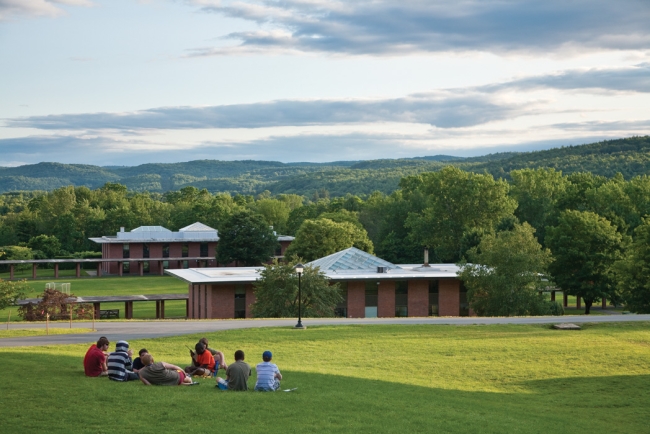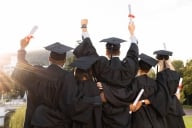You have /5 articles left.
Sign up for a free account or log in.

Courtesy of Landmark College
Accessibility remains one of the key issues for digital learning professionals looking to catch up to the needs of the modern student. At last month’s Online Learning Consortium Accelerate conference, seemingly everyone in attendance hoped to come away with new insights into this thorny concern.
Landmark College in Vermont might offer some guidance. The private institution with approximately 450 students exclusively serves students with diagnosed learning disabilities, attention disorders or autism. Like all institutions, it’s still grappling with how best to serve students in the digital age, whether in the classroom or at a distance. Here’s a glimpse at the institution’s philosophy, courtesy of Manju Banerjee, Landmark’s vice president for educational research and innovation since 2011.
“Technology Allows a Student to Personalize Their Learning Space”
Banerjee wants to steer the conversation around students with learning disabilities away from such terms as “assisted technology” and “adaptive technology.”
“That word ‘assisted’ carries the connotation that you have some deficit and it’s going to assist you in accommodating that deficit,” Banerjee said. Instead, the institution gives students a broad range of options -- apps, embedded native software, hardware suites -- that allow the student to be self-determined. “Technology is a pathway to a goal, not the goal,” Banerjee said.
The institution doesn’t house all of its technology in a separate tech lab, tutoring lab or IT office, though the institution has all of those areas. Instead, faculty members bring technology directly to the students and adapt their usage to the students’ needs.
Students also get introduced to new technology and “intelligent tools” like virtual reality goggles and 3-D printers at Landmark’s institute for research and training. A student group created a virtual reality game-based environment “where students can pick up principles of correlation before they have to learn it in class”; that group presented their product at a Massachusetts Institute of Technology symposium in September.
“Giving Options Is Good, but Don’t Give Too Many Options”
In general, Landmark prefers “nondirective coaching” to a more prescriptive approach, according to Banerjee.
“We’re careful as we elicit from the student their preferences and choices that we don’t overwhelm them with the bells and whistles from the technology,” Banerjee said.
Students can get swamped if they’re presented with too many decisions -- particularly if they aren’t fully self-aware about their learning styles. Banerjee wants students to see technological tools as opportunities to work faster, rather than as antidotes to defects.
“What we get from the student as we talk with them is not so much about ‘what are your weaknesses,’” Banerjee said. “We’re kind of done with that word. We talk about how can we do something easier, smarter, more effectively, more efficiently. How can we save time?”
Jen Morris, associate professor in Landmark's photography, fine and performing arts department, lets students focus on the natural curiosities they display early on in the semester. A student who takes an interest in light imaging, for instance, can keep doing that and eventually help peers who are focused on other aspects.
"It’s very much a laboratory setup, working and discussing and looking at things," Morris said. "We’re moving around, even though we are [working] inside the computer in some of my classrooms. There’s definitely still this nimbleness "
To give students the best possible experience, the institution trains faculty members on technology during the professional development sessions at the beginning of each semester. Events throughout the semester like talks and workshops augment those structured programs, and the institution’s tech staff sits down one on one with faculty to help them make the most of Canvas, Landmark’s LMS.
Landmark offers dual online enrollment for public high school students in Vermont, as well as five online postbaccalaureate professional development certificate courses. But the institution hasn't yet offered full degree programs online, largely because the online format, particularly in the asynchronous realm, is "not friendly" to learners with disabilities, Banerjee said.
Tools of the Trade
Kevin Keith, assistant professor of mathematics and computer science, has been employing and refining since 2012 a flipped-classroom approach to his introductory computer science course.
Before that, he frequently found that students with disabilities took much longer than average to finish a coding assignment or remember key details from his lectures. He got the idea for innovation from his experience as a high school teacher, when he gave an autistic student the opportunity to preview his lecture materials in the hours leading up to each class session.
On his own, Keith spent a full summer developing 24 different video lessons. Now class time is lab time for working on and discussing programs with Keith, while students absorb lectures and run through practice exercises online outside of class.
He’s made some adjustments along the way, such as incorporating periodic checks that ensure students complete the entire lecture and offering quizzes at the start of each class where students can use their homework notes.
According to Keith, the flipped approach allows students to pause and rewind pieces of the lecture they might have missed the first time, and puts less pressure on students who need more time to process the information than a class session typically allows. He’s gotten a lot more assignments turned in complete and on time, and numerous students have commented that this arrangement is what they had expected but hadn’t received at a more traditional college.
For instructors at other institutions looking to reach out to those types of students, Keith recommends a piece of advice he received early in his career: “Say everything you write, and write everything you say. It’s an easy way to capture those people who have auditory processing issues, as well as those people who are dyslexic.”
Beyond experiments like Keith’s, the institution has established three tools as essential components of its technology offerings, Banerjee said:
- Dragon Naturally Speaking, which translates speech to text.
- Kurzweil, a suite of text to speech, spell-checkers and other assistive technologies.
- X-Mind, which allows the creation of outlines and organizational charts.
Morris has employed LiveScribe, which transforms handwritten text into typed notes, to great acclaim from her students.
The institution has also been undergoing a research project funded by the National Science Foundation that employs Voice Thread -- an app that allows students to write and draw responses directly on their smartphone screens -- to determine whether synchronous or asynchronous discussions prompt more student engagement. Results from that project haven't yet emerged.
"Landmark is primarily a teaching college, but we have a very robust research institute," Banerjee said.








